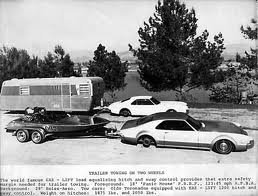Problem:
I have an older f150 4x4 with a low GVWR of 6000lb. With 600 lb toungue weight (trailer empty) and me and wife and dog I am probably a little over that when we pull out without supplies, clothes,etc. However-
The trailer is 500 lb under what it is rated for ( 4000 vs 4500) and well under what the truck is rated to pull ( 4000 vs 6600---gcvwr is 11500. )
So, because the truck is rated at 6000 gvwr -when I add, say, 300 lb of gear in the bed I am over ( that is high- but I'm using it as a top number). What is the feasability of loading that 300 lb in the trailer further back enough that I am not adding to tongue weight and, subsequently, not adding to cargo load in truck bed? Yes- I do have a wdh system. It seems like a no-brainer except I am always cautious of not getting too light in the front . I also realize that the whole tongue weight issue is tricky depending on where the axles are located as indicated by jack's issues of having to relocate his axles on his 17 footer.. Any way- any thoughts are appreciated.
Rick
I have an older f150 4x4 with a low GVWR of 6000lb. With 600 lb toungue weight (trailer empty) and me and wife and dog I am probably a little over that when we pull out without supplies, clothes,etc. However-
The trailer is 500 lb under what it is rated for ( 4000 vs 4500) and well under what the truck is rated to pull ( 4000 vs 6600---gcvwr is 11500. )
So, because the truck is rated at 6000 gvwr -when I add, say, 300 lb of gear in the bed I am over ( that is high- but I'm using it as a top number). What is the feasability of loading that 300 lb in the trailer further back enough that I am not adding to tongue weight and, subsequently, not adding to cargo load in truck bed? Yes- I do have a wdh system. It seems like a no-brainer except I am always cautious of not getting too light in the front . I also realize that the whole tongue weight issue is tricky depending on where the axles are located as indicated by jack's issues of having to relocate his axles on his 17 footer.. Any way- any thoughts are appreciated.
Rick


